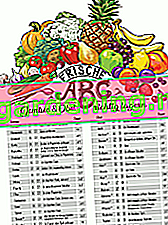
Use with or without a bowl?
The butternut has a shell that is theoretically edible. But unlike Hokkaido, it is seldom consumed. The reason is that the shell does not become soft enough even after long roasting or boiling.
also read
- Peeling the pumpkin - good tips for unwieldy fruit
- Peeling Hokkaido pumpkin - does the peel really have to go?
- Fertilize pumpkin properly - with these tips it works
As only the pulp is used in the preparation, the butternut, as this type of pumpkin is called in German, has to be peeled.
The challenges of peeling
Peeling a butternut is not as easy as it is, for example, a potato. When removing the skin of this type of pumpkin, several challenges await the cook:
- the pumpkin is big, heavy and unwieldy
- cannot be held well in the hand
- the round shape does not stand securely on the wooden board
- the shell is smooth, the knife slips off easily
- the shell is thick and requires force to cut
These challenges cannot be easily overcome for an inexperienced hobby cook. A few tricks and tips are certainly welcome.
The two halves of the butternut
The butter squash, as the butternut is also called, is not a ball-shaped fruit. It is rather elongated with the center being slimmer than the rest of the fruit.
If the fruit is cut lengthways, you can clearly see that there is a cavity with pips only in the lower half.
The upper half, on the other hand, is completely filled with pulp.
For peeling, the butter squash is therefore divided into the upper and lower parts and processed separately.
Helpful kitchen utensils
In order to cut up the butternut and then peel it, you will need the following kitchen utensils:
- a large and sharp saw knife
- a large wooden board
- a tablespoon
Cut the butternut in the middle
Before the pumpkin is peeled, it must first be washed thoroughly. Ideally, it should be brushed off with a vegetable brush under running water.
Then lay the pumpkin flat on a wooden board and cut it in half. However, the cut is not made exactly at the narrowest point. Move the knife a few inches away from the center, towards the half with the handle. After cutting through, the lower half will be slightly larger, but will contain the entire core housing.
In a second step, cut off the two ends.
Remove the skin from the upper half of the pumpkin
- Place the top half of the pumpkin upright on the wooden board.
- Hold the pumpkin half with one hand while you cut away the peel with the other hand.
- Place the knife on top of the fruit and guide it with a saw movement and light pressure along the line all the way down.
- Continue this step until half of the shell has been removed.
- The pulp from the skin can now be processed further according to the recipe.
If only half of the butternut is enough for the current recipe, you can leave the other half unpeeled and keep it in the refrigerator for several days.
Tips
Do not cut the skin too thin, as there is very fibrous pulp immediately underneath. This should be removed generously.
Remove the skin from the lower half of the pumpkin
The lower half of the pumpkin not only has to be freed from the skin, the core also has to be detached.
- Place the pumpkin half upright on the wooden board.
- Cut the pumpkin lengthways into four parts.
- Remove all seeds with a tablespoon.
- Set up a pumpkin quarter and cut off the peel in strips from top to bottom, as described above for the top half of the pumpkin.
- Remove the peel from all quarters one at a time.
Tips
Don't throw away the kernels. Dried and roasted, they make a delicious snack.
When the shell can stay on
The shell of a butternut usually has to be removed, but not always. For example, if the pumpkin pieces are finely pureed after cooking, the peel can stay on. It is then chopped up so small that it does not bother you any further.
Conclusion for quick readers:
- Shell: Although edible, it remains hard even when cooked; Peeling is necessary
- Exception: when the cooked pumpkin is pureed
- Preparation: Wash the pumpkin thoroughly under running water
- Cut in half: use a large saw knife; thicker pumpkin part should be a little larger
- Halve: lay flat on a wooden board; cut through the middle; cut off both ends
- Upper half: stand upright on the board; hold tight; Peel off the peel from top to bottom
- Tip: Peel thickly to remove the fibrous pulp underneath
- Lower half: stand upright on the board; quarter; Remove the core casing
- Lower half: set up quarters one after the other; Peel off the peel from top to bottom
- Tip: Half a butternut can be stored unpeeled in the refrigerator for a few days

The garden journal freshness-ABC
How can fruit and vegetables be stored correctly so that they stay fresh as long as possible?
The garden journal freshness ABC as a poster:
- Order here cheaply as an A3 print for your kitchen
- as a free PDF file to print out yourself








